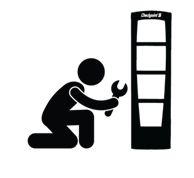
Out of control spending may be okay for the federal government (Let’s be frank 20+ trillion of debt seems pretty out of control to most of us) but as a store owner or manager out of control expenses will bury your company. I am sure that you are looking carefully at where you spend your cash, reviewing controllable reports and monthly expenses. What you may not be considering is how operating a store without inventory controls in place can be negatively impacting the profits of your store.
When I talk about inventory controls I am not simply referring to activities on inventory night, I am talking about everything the store does all year to control merchandise. For example, the store I work for receives their pallets of freight several times a week. Included in these pallets are sealed plastic shipping boxes that hold individual pieces of merchandise. Some of these boxes have different colored seals and colored seals are indicators that the merchandise inside is high value/high theft goods requiring strict controls. The merchandise in these boxes requires security devices or immediate lock-up. When I was a Loss Prevention Manager for another company we had a lock-up cage we staged at the trailer receiving door. As specific high-risk merchandise came off of the trailer that product immediately went into the cage. That merchandise had to get to its department following a very specific path and if I observed any deviation from that path I was investigating the issue. The store where my daughter works requires all jewelry shipments be taken immediately to the jewelry counter, counted against the invoice and stocked. Jewelry is not allowed to sit out until it is convenient to secure it. Having a detailed plan for identifying high-risk products, verifying counts against invoices right away and immediately securing it are smart steps in preventing inventory shortage from getting out of control.
Electronic article surveillance (EAS) systems are another key piece of a sound inventory control strategy. When I mentioned securing products above it does not necessarily mean that merchandise has to go into a lock-up case. Most merchandise can be protected against theft with EAS labels, hard tags, wraps and other protective devices (for example Sensormatic has a product called Flexible Safers that can hold items and still give EAS protection). There are some things that a display case is appropriate to display merchandise in such as high-end jewelry. By the same token, there are EAS products suitable for costume and less valuable jewelry. Inventory control of such pieces of merchandise means tagging these items by a team of trusted employees before they are on the sales floor and accessible by other employees or shoppers. An EAS system also includes the installation of towers at all points of entrance and exit. A common error on the part of many retailers is the failure to place towers near vendor doors and employee-only entry doors. Failing to protect these doorways is a misstep in recognizing the reality of employee theft and the impact it has on store profitability.
Inventory control also takes place in in-store training programs. Teaching employees how the customer service they provide helps prevent shoplifting plays a part in inventory control. Training front end supervisors and cashiers how to properly handle EAS alarm activations determines how much merchandise you may or may not recover from potential thieves. Even the proper training of specialists who show merchandise from lock-up showcases impacts the potential for a crook to steal. How many pieces of jewelry should be out of a case to show a customer at any time? One, two, or three items? You have to teach your team what you expect and how someone may try to trick them while they are showing merchandise.
Inventory control is a year-round effort. It encompasses more than locking up merchandise or preparing for an annual inventory. Inventory control requires an in-depth look at where losses can take place, how they occur and who may be causing the losses. Once you do that you can implement solutions to the problem by creating a comprehensive shortage prevention strategy. Do that and you keep from losing control over your store profit line.

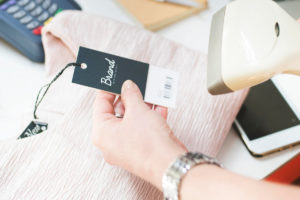
 Have you ever found yourself in a situation where you have to make a decision on a purchase and you have to determine what is going to be best for your situation? I know that car shopping is one of those purchases where I have to take multiple factors into consideration and it isn’t always just about cost. I have to be able to accommodate at least 5 adults and perhaps even 6 if my mother-in-law is included in a ride. I need to get decent gas mileage because I never know who may have to use it and all of our work so I don’t want to fill it every day. I need dependability, I’ve had too many vehicle break-downs and I don’t want a breakdown on my wife if I can help it. Before I make a purchase I search customer reviews of vehicles and automotive expert ratings on websites such as Edmunds or Kelly Blue Book. The vehicle has to meet my requirements or I have to pass on it regardless of how good the deal may appear to be. The same thing can be true for a retailer when determining the best Electronic Article Surveillance (EAS) System and tags to use to combat theft related shortage.
Have you ever found yourself in a situation where you have to make a decision on a purchase and you have to determine what is going to be best for your situation? I know that car shopping is one of those purchases where I have to take multiple factors into consideration and it isn’t always just about cost. I have to be able to accommodate at least 5 adults and perhaps even 6 if my mother-in-law is included in a ride. I need to get decent gas mileage because I never know who may have to use it and all of our work so I don’t want to fill it every day. I need dependability, I’ve had too many vehicle break-downs and I don’t want a breakdown on my wife if I can help it. Before I make a purchase I search customer reviews of vehicles and automotive expert ratings on websites such as Edmunds or Kelly Blue Book. The vehicle has to meet my requirements or I have to pass on it regardless of how good the deal may appear to be. The same thing can be true for a retailer when determining the best Electronic Article Surveillance (EAS) System and tags to use to combat theft related shortage. We are excited to announce our partnership with Johnson Controls/Sensormatic. Sensormatic is one of the oldest and largest Electronic Article Surveillance (EAS) manufactures in the world. Loss Prevention Systems has deep loss prevention and EAS experience.
We are excited to announce our partnership with Johnson Controls/Sensormatic. Sensormatic is one of the oldest and largest Electronic Article Surveillance (EAS) manufactures in the world. Loss Prevention Systems has deep loss prevention and EAS experience.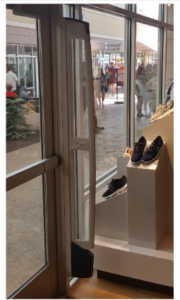 Pricing is also a factor. Sensormatic line of systems will fit a wide range of budgets depending on the features you select. We also have people counting, and data reporting. This gives the Retailer important intelligence on customer traffic and flow. We have seen many of our customer’s significantly reduce expenses in both payroll and operating costs by having this data. Store hours can be adjusted and you can adjust staffing to fit the real world.
Pricing is also a factor. Sensormatic line of systems will fit a wide range of budgets depending on the features you select. We also have people counting, and data reporting. This gives the Retailer important intelligence on customer traffic and flow. We have seen many of our customer’s significantly reduce expenses in both payroll and operating costs by having this data. Store hours can be adjusted and you can adjust staffing to fit the real world. 



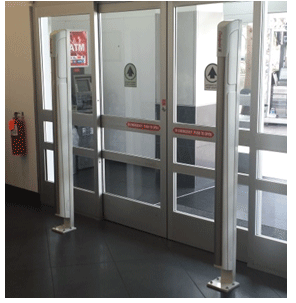
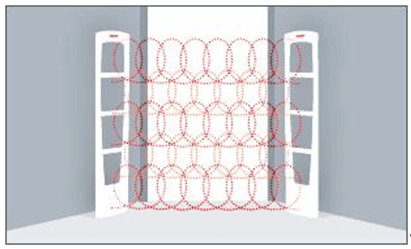 Tagged merchandise, metal racks, and electrical wiring in this incidental detection zone can have an adverse effect on system performance. As a general rule, tagged merchandise should be equivalent of at least ¾ of you doorway aisle width away from each EAS pedestal. Example; tags should be no closer than 4.5 feet, in a 6 foot doorway. Where possible: metal racks and electrical wiring should be 5 feet or more away from the system.
Tagged merchandise, metal racks, and electrical wiring in this incidental detection zone can have an adverse effect on system performance. As a general rule, tagged merchandise should be equivalent of at least ¾ of you doorway aisle width away from each EAS pedestal. Example; tags should be no closer than 4.5 feet, in a 6 foot doorway. Where possible: metal racks and electrical wiring should be 5 feet or more away from the system.